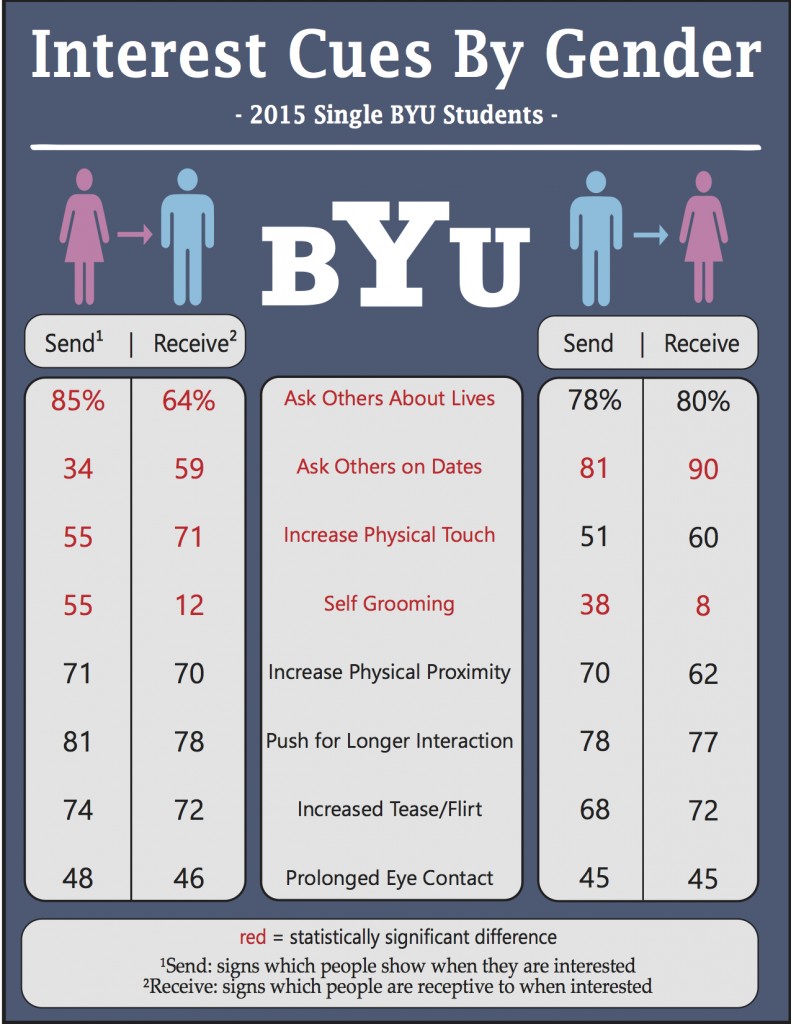
Bradley Anderson spent more than 200 hours this summer analyzing data, and it wasn’t for a class.
Anderson, a BYU student from Tacoma, Washington, studying international relations and Japanese, created a Qualtrics survey about dating and distributed it through Facebook. He hoped the survey would answer his own questions about the dating culture at BYU.
“I asked one of my friends on a date, and she said she’d been here for a year and a half and had not been asked on a single date her entire time here. And that just really surprised me,” Anderson said. So he started asking questions about the dating environment at BYU, eventually leading him toward the survey from which he could collect quantifiable information.
“I found that everyone else here thought that there’s a weird dating culture here, and it wasn’t just me,” Anderson said.
Mark Ogletree, an associate professor in the Department of Church History and Doctrine, teaches marriage and family classes and regularly asks his students what they think of the dating atmosphere at BYU.
“Just what I hear from students, there is room for improvement,” Ogletree said. “I’m seeing a lot of hanging out, that’s still alive and well. A lot of students are not dating. If a guy asks a girl out formally, then there’s a panic.”
Ogletree referred to a statistic displaying a discrepancy between students’ highest priority, which is marrying in the temple, and the frequency of dates students are actually going on, determining that “the majority of students would like to date more.” The data was published in “Shield of Faith: The Power of Religion in the Lives of LDS Youth and Young Adults” by Brent L. Top, Bruce A. Chadwick and Richard J. McClendon in 2010.
The survey Anderson created was distributed in June 2015 and open for six to eight weeks. It contained 26 questions about frequency of dates, dating intentions, culture-isms, “define the relationship” acceptability and reception to signs of interest.
“I kept it fairly objective and academic,” Anderson said.
The survey received a serious response; within two hours there were 64 responses, and by the time the survey closed there were almost 1,000. Though the survey-takers were mostly from BYU, they were also from BYU-Idaho, other Utah universities and even colleges outside of Utah.
A startling statistic Anderson found was that BYU students are only averaging two dates per month.

“Males are told to be thinking two dates a week,” Anderson said. According to Ogletree and Anderson, the First Presidency and church leaders advise singles to date more frequently.
“I think if students knew that frequency (of an average of two dates a month), they would step up a little more. If there’s a perception that ‘wow, no one’s really dating,’ then more students would engage,” Ogletree said.
Sabrina Leiva, a student from Woodbridge, Connecticut majoring in Asian studies, said she feels going on two dates a month is adequate.
“If you aren’t in a relationship, then that seems pretty normal. By going on two dates a month you’re fulfilling what we’ve been asked to do by General Authorities. Two is good because it’s not too much; if you’re constantly going on dates it means you can’t settle,” she said.
One cultural question the survey focused on was whether or not it is acceptable for females to ask males on dates.
“For me, I knew that the answer was yes. I’d been asked on dates,” Anderson said. When he first returned home from his mission he said he was asked out on six dates.
Student Ethan Christensen said for him, the answer was no because he had never been asked out by a female.
Christensen, from Fruit Heights, Utah studying international relations and minoring in statistics, helped Anderson with the statistics and grunt work of putting all of the data from the survey into software to calculate the results.
The majority of survey respondents said women asking men out is acceptable. But according to the survey, only one out of three females are asking males out and that was every other month. And so far, there is no way of knowing whether or not those dates are accepted.
Christensen, Anderson and their other team member Mike Brown, a graduate student from Martinez, California, studying marriage, family and human development, also speculated about what their next step will be with the information they gathered from the survey. They plan to distribute another survey in mid-October or early November. The theme of this survey will be dating expectations.
“There’s a lot of talking about what dating is or isn’t here in Provo, and we’re hoping to get some actual data that at least is current to now,” Christensen said.

The first survey was well thought out, but casual, according to Christensen. The second survey will have the approval of BYU’s Institutional Review Board, which is needed when studying human subjects, and the goal is to have a lasting impact on the current dating population.
“There is a dating famine that is taking place,” Anderson said. “And it’s not that people don’t want to date — they do. They’re getting tired of not knowing what’s going on. There’s this ambiguity that’s floating around and that’s something we’re going to address.”
The concept that there is a dating famine has been recognized nationwide. A book called “Date-onomics: How Dating Became a Lopsided Numbers Game” by Jon Birger talks about how dating is changing in America.
“Date-onomics” was published this summer and has generated reviews from The New York Times and The Washington Post. Birger even wrote a story for Time Magazine that adapted the ideas from his book to address what two religions, one of them being the LDS Church, prove about the dating crisis.
BYU’s campus is not immune to dating trends such as Tinder or ghosting that are popular in society. The goal of Anderson’s survey was to define what BYU’s dating norm is so that students can determine where they fall on that spectrum.
“Humans are social creatures in the sense that they start to wonder what ‘normal’ is so that they can either behave normally or go out of their way to be a counter-culturalist,” Anderson said. “Being able to provide some descriptive data would maybe relieve some of that pressure.”




